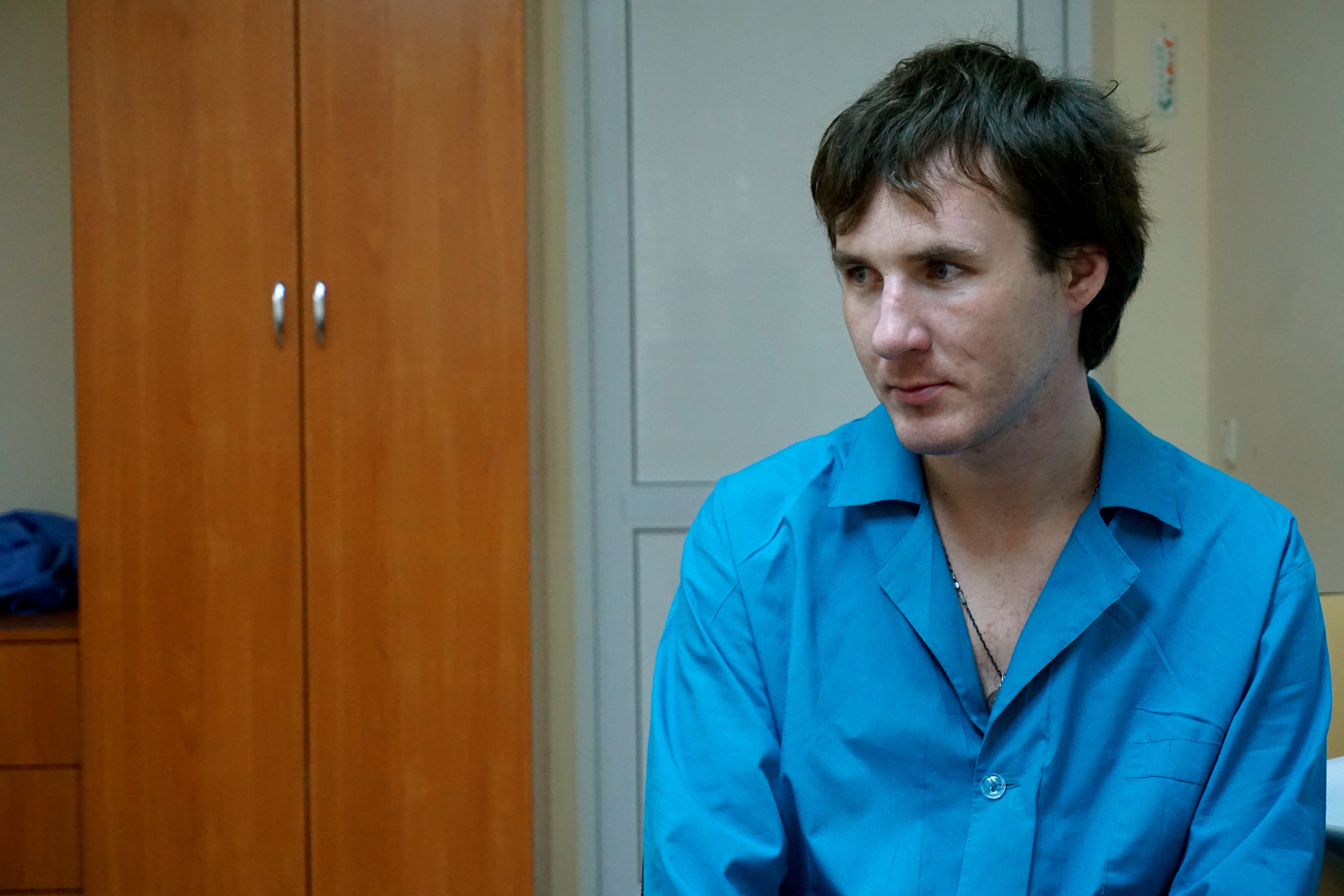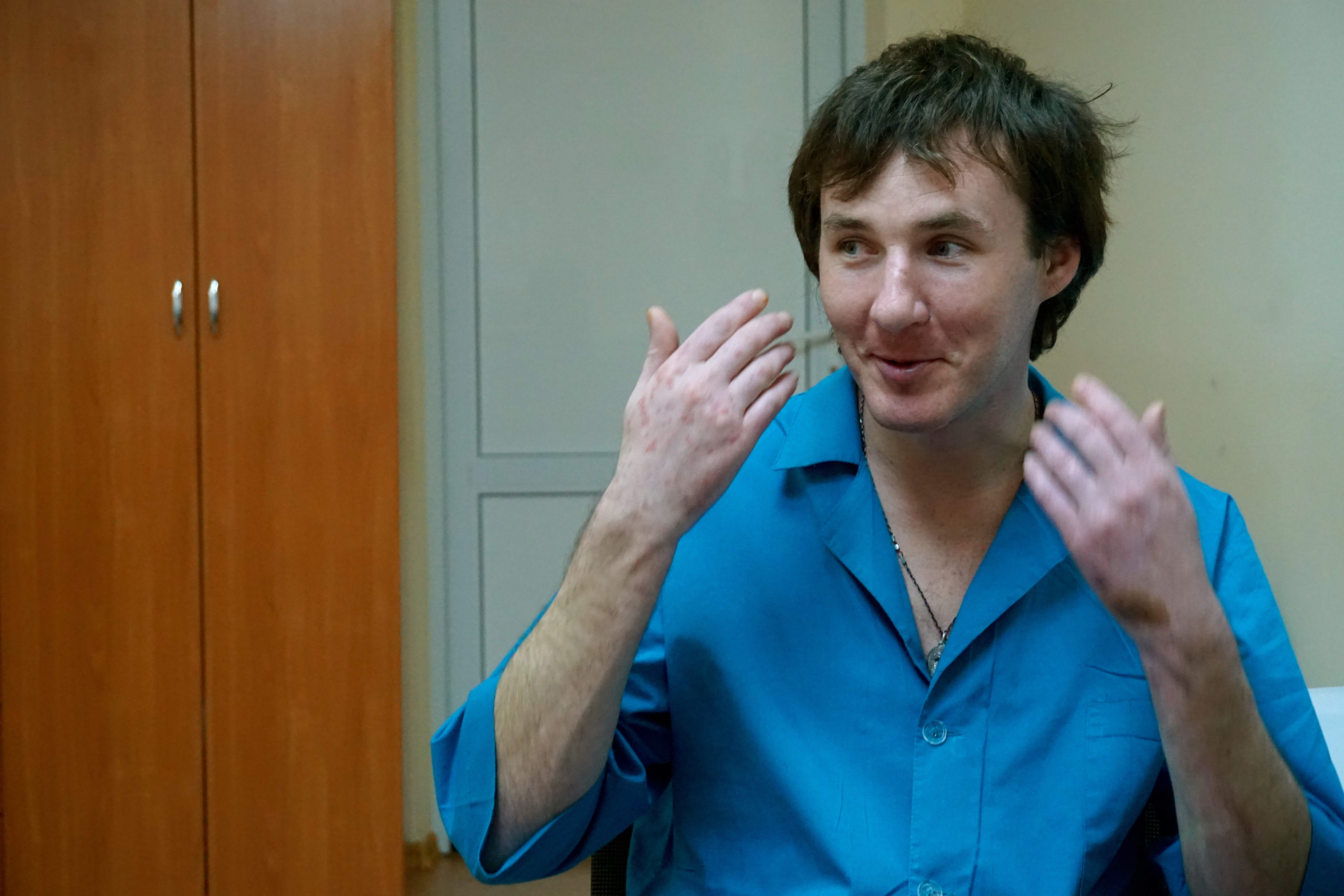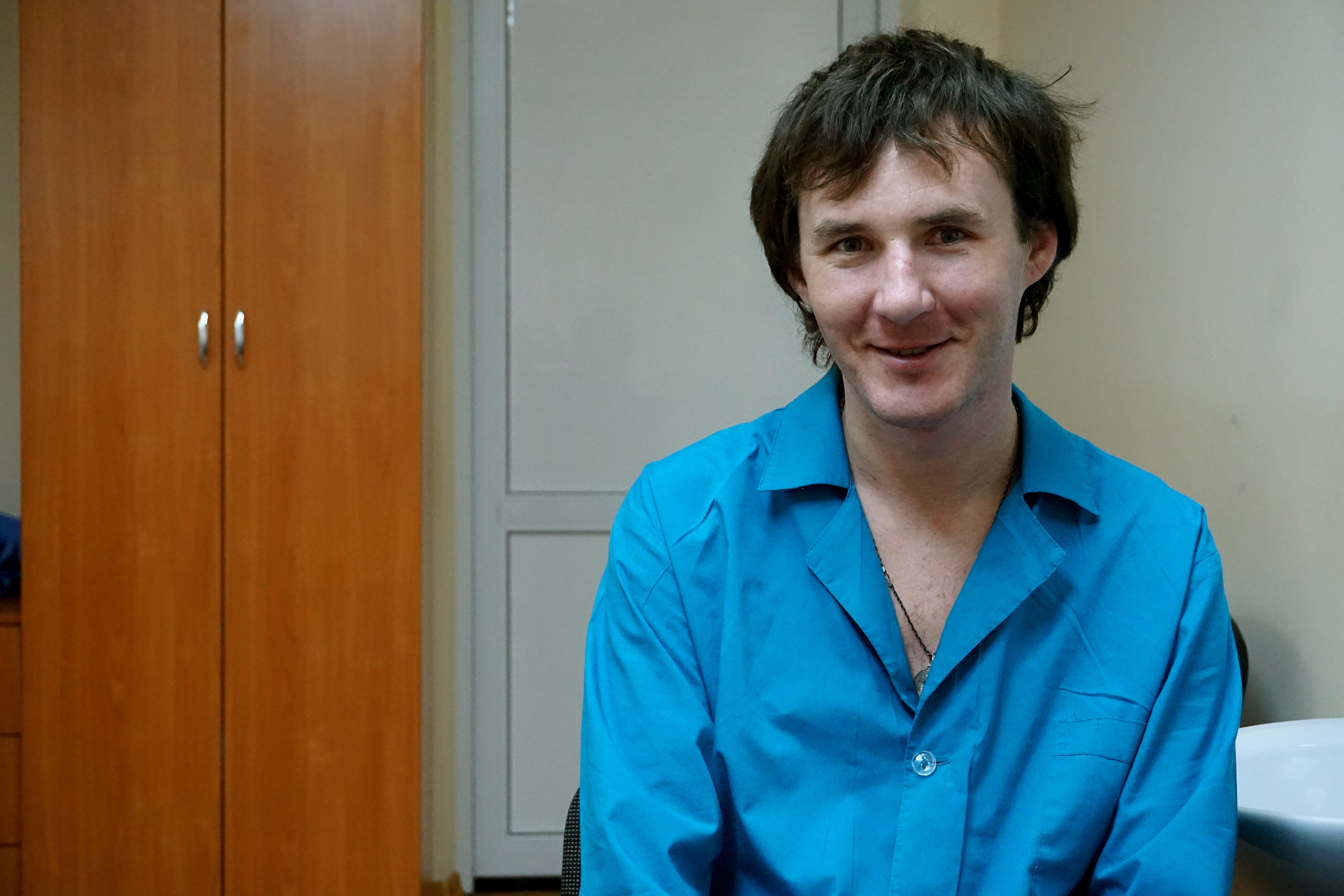‘I Can’t Believe I’m Free’: A Ukrainian POW Returns Home
Nolan Peterson /
KYIV, Ukraine—Vadym Krypychenko was sure he was going to die.
His vehicle had broken down along the front lines in eastern Ukraine near the village of Verkhniotroitske. It was Aug. 10, 2015, only four days before the end of his military service commitment and his scheduled return home.
Krypychenko, a private in the Ukrainian army’s 53rd separate mechanized brigade, found himself alone in no man’s land. When an intelligence unit of separatists appeared and approached with weapons drawn, he assumed they were going to execute him.
“I was mentally ready to die,” Krypychenko, 36, tells The Daily Signal in an interview following his release Feb. 20 after 195 days as a prisoner of war in the hands of combined Russian separatist forces.
“It was a wonder that I lived,” he adds.
Months into his captivity, while isolated in solitary confinement and with his body covered in wounds from bouts of torture, Krypychenko turned to his religious faith, and even a little humor, to avoid succumbing to despair.
“I felt grateful to God,” he says. “I’m a believer. I was grateful that God saved me from the worst. I was still alive at least. But the hardest part was not knowing what to expect each day.”
In the dank solitude of his cell, Krypychenko would laugh to himself as he recalled funny childhood memories. In particular, he remembered a trip to a zoo as a boy when a friend stuck his fingers inside a bear cage.
“The bear bit off one of his fingers,” Krypychenko says, smiling. “At the time, it was horrible. But when I thought back on it, it seemed so funny for some reason. Humor is helpful in all situations.”
Torture and Wounds
Krypychenko sits in an office in a Kyiv hospital wearing loose blue scrubs. His dark brown hair is long and disheveled. He is clean-shaven and jokes about the beard he grew in captivity. Light blue scars line his pale face and the bridge of his nose.
He speaks softly and succinctly, sitting slightly hunched forward with his shoulders rounded. He seems tired but not exhausted, exuding an air of simultaneous relief and being slightly overwhelmed by his surroundings. Yet he cracks a small grin as he matter-of-factly explains the conditions of his captivity.
“A couple times, I felt like I was losing hope,” he says. “But I strengthened myself.”

Vadym Krypychenko, a private in the Ukrainian army’s 53rd separate mechanized brigade, was held for 195 days as a prisoner of war. (Photo: Nolan Peterson/The Daily Signal)
As part of ongoing negotiations between Kyiv and the Russian-backed separatist territories in eastern Ukraine, the separatists released four Ukrainian prisoners of war, including Krypychenko. According to Ukrainian news reports, Ukraine released five captured separatists and a priest in exchange for the servicemen.
The interrogations were “very rude,” Krypychenko says, as he describes how his captors tortured him with electric shocks and beat him with their fists and wooden planks.
The first interrogation lasted for about three hours, he explains, but they got shorter as time went on. He was never threatened with execution during those sessions, but the guards occasionally made offhand death threats.
As to the nationality of his interrogators, whether Ukrainian separatists or Russian intelligence operatives, Krypychenko says he had no reason to believe any were Russian.
His captors held Krypychenko in solitary confinement for the entirety of the 195 days. They allowed him to leave his cell and go outside under open skies only two times, each at night for about two minutes, so that he could smoke a cigarette. He recalls:
I became indifferent to everything at the end of my captivity. Food even began to lose its taste. I used to ask, ‘Why me? How could this happen only four days before I was supposed to go home?’
No Escape
Throughout his captivity, Krypychenko was held in three separate locations. His captors placed a bag over his head when transporting him, which, in addition to his isolation in solitary confinement and lack of contact with fellow prisoners, robbed him of any sense of his surroundings.
“There was no possibility to escape,” he says. “I never knew where I was.”
He also was physically ill prepared for an escape attempt.
While never denied food or water, sparse meals left Krypychenko weak. He wore only trousers and sandals—no shirt or shoes. Inside his cell he had nothing but a mattress and a blanket, a plastic water bottle he used as a pillow, and a few cigarettes. His worldly possessions were all gifts from a benevolent guard who, Krypychenko explains, was the only person to demonstrate any compassion.
“He was the only one to show me kindness,” Krypychenko says.
This same guard allowed Krypychenko to make his two trips outside to smoke a cigarette, allowed him to call home on a cellphone from time to time, and ultimately delivered news of his release.
“I couldn’t believe it,” Krypychenko says. “The guard who helped me, he came and told me I was going to be released. I didn’t believe it at first. I couldn’t believe that I was going home.”
Stalemate in the Conflict
The exchange of prisoners between Kyiv and the self-proclaimed separatist republics has been a drawn out, sticky point of contention marring full implementation of the Minsk II cease-fire deal, which went into effect in February 2015.
Prisoner exchanges often occur outside official government channels, with personal favors, bribes, and the efforts of individual families to get their soldiers back driving the negotiations. Consequently, captured Ukrainian soldiers have become both political bargaining chips and a means to extort bribes for their release.
The return of prisoners was supposed to have been accomplished in March 2015, within five days after both sides withdrew heavy weapons from the front lines, according to the terms of the Minsk II cease-fire.
The weapons pullback was scheduled for two days after the truce went into effect Feb. 15, 2015. But more than a year later, the Ukraine war appears to be heating up again.
On Monday, Kyiv reported 69 attacks on Ukrainian positions from a variety of combined Russian separatist weapons, including 82 mm and 120 mm mortars, grenade launchers, machine guns, and small arms. At least five Ukrainian troops died in combat last week.
Both sides periodically accuse the other of violating the cease-fire’s terms, delaying the full release of prisoners as a way to maintain negotiating leverage.
It is not immediately clear how many separatist fighters are in Kyiv’s custody. An unconfirmed statement in October by the self-proclaimed Donetsk People’s Republic (one of the breakaway territories in eastern Ukraine) claimed that more than 1,000 of its fighters were imprisoned.
And while combined Russian-separatist forces have released about 3,000 Ukrainian troops from captivity since the conflict began, more than one year after the Minsk II cease-fire, 123 Ukrainian soldiers remain held prisoner, according to the Ukrainian Security Service, or SBU.
When he was told about his impending release, Krypychenko says, he was conflicted, flooded with simultaneous feelings of relief and guilt. He knew that other Ukrainian prisoners of war had been in captivity longer—some for more than a year—and many of them never had been properly treated for their injuries.
“I thought if I had the possibility, I would have refused to go home and let someone go in my place,” he says.
The four prisoners released Feb. 20 were driven to a location on the front lines, where they met Ukrainian officials. They immediately received cell phones to call their families with the good news.
“The first person I called was my mom,” Krypychenko says.

Krypychenko credits his religious faith and a good sense of humor with his ability to maintain hope throughout his captivity. (Photo: Nolan Peterson/The Daily Signal)
On-the-Job Training
If taken prisoner, U.S. military personnel are required to abide by the “Code of Conduct for Members of the Armed Forces of the United States.”
The Code of Conduct is an “ethical guide” for personal behavior in captivity. It addresses escape attempts, what information is permissible to give the enemy, and how to handle preferential treatment and early release. The document acknowledges the human limits of resistance to torture, as well as how to avoid being exploited for propaganda.
Cadets at the U.S. Air Force Academy, for example, are required to memorize the six articles of the Code of Conduct and recite them verbatim while under physical duress. (Punishment for mistakes usually includes a lot of push-ups and burpees.)
Additionally, U.S. military personnel considered at risk of capture are required to go through what is called Survival, Evasion, Resistance, and Escape (SERE) training, which includes mock capture, interrogation, and torture scenarios.
The training draws on decades of lessons learned from returned prisoners of war, providing trainees an opportunity to confront the sometimes ethically complicated decisions that arise in captivity.
Krypychenko, however, said the Ukrainian military never provided him any formal training on conduct as a POW. While under the threat of torture and extended captivity, he could rely only on his personal judgment. He basically had to wing it.
The interrogation sessions, for example, focused on Ukrainian troop positions and the amount and type of weaponry positioned on the front lines.
“Of course, I didn’t tell the truth,” Krypychenko says. “I pointed to wrong places on the map. I had friends in those positions. I couldn’t tell the truth. I didn’t want my friends to get hurt.”
‘Traces of Trauma’
Alexander Naumenko, the civilian doctor who first treated Krypychenko and the three other prisoners of war released Feb. 20, says this was his first time treating returned prisoners of war. He had no specific protocol to follow for their rehabilitation.
“We don’t have a lot of expertise with this,” the doctor tells The Daily Signal. “But we have all the specialists we need.”
Naumenko says all four returned POWs were in stable condition with no fresh wounds to treat when they arrived. Their bodies, however, offered clues to their ordeals in captivity.
“We see the traces of trauma, on their skulls and across their whole bodies,” Naumenko says. “But it’s impossible to tell what caused these traumas. It’s impossible for me to say it was torture.”
Beyond the physical scars, Naumenko says, the four released soldiers all demonstrated symptoms of post-traumatic stress.
“They are very depressed,” he says. “Their psychological conditions require long-term medical treatment.”

“When I wake up, I still have to remind myself that I’m free,” says Krypychenko. (Photo: Nolan Peterson/The Daily Signal)
Vadym Krypychenko suffered no permanent or disabling injuries from his captivity. The wounds inflicted by the electric shocks and beatings have healed, leaving behind faint scars. His skin is ashen white from months without sunlight. Yet his time as a POW has affected him in more subtle ways.
He says he suffers from insomnia—not due to flashbacks or lingering fear from his captivity, he insists, but because he still can’t believe that he actually is free. The mental “armor” he put up to maintain hope and strength in the darkest hours of his captivity is not so easy to take down, he says:
When I wake up, I still have to remind myself that I’m free. It’s not a tragic emotion; I only have to remind myself that I’m finally safe. I just cannot get to the idea that I’m free.
Life Goes On
Before Krypychenko was drafted into military service in 2014, he was an auto mechanic living in Dnipropetrovsk, Ukraine’s third largest city.
Once released from the hospital in Kyiv, Krypychenko plans to return home and resume his old life.
“I want to go home,” he says. “I don’t want to be a military man anymore.”
After the interview with The Daily Signal, Krypychenko steps outside the back door of the hospital and smokes a cigarette. He wears a cardigan over his hospital scrubs. The day is gray and rainy, but he has open sky over his head.
He takes a long, last puff of his cigarette, tosses it to the ground, and puts out the butt with the twisting heel of his sandal-covered foot.
“I still can’t believe I’m free,” he says, shaking his head and smiling.
